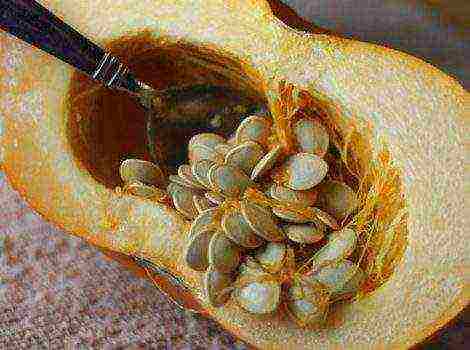Content
Correct cultivation of rocumball garlic
Garlic is one of the main horticultural crops that every summer resident grows on his site, but few people know about exotic and unusual wild varieties. One of these is garlic-flavored onions, which are actively grown in Europe and southern countries, but have not received proper distribution in Russia. It is also called elephant garlic or simply rockambol. This hybrid of onions and garlic will be discussed further.
What is the name of the garlic-flavored onion?
Garlic-flavored onions are a rather rare phenomenon, such a variety of rocambol is called, looking at which it is not immediately possible to determine which culture it belongs to. It is somewhere in between leeks and garlic.
By the appearance of the plant, we can say that its wide, green leaves are extremely similar to leeks, but the head that divides into several cloves is taken from garlic. It is worth noting that the taste of rockumbol remains at the highest level, it is less pungent than the usual garlic, and there is also no pronounced smell. Its application is extensive. Can be eaten as a condiment.
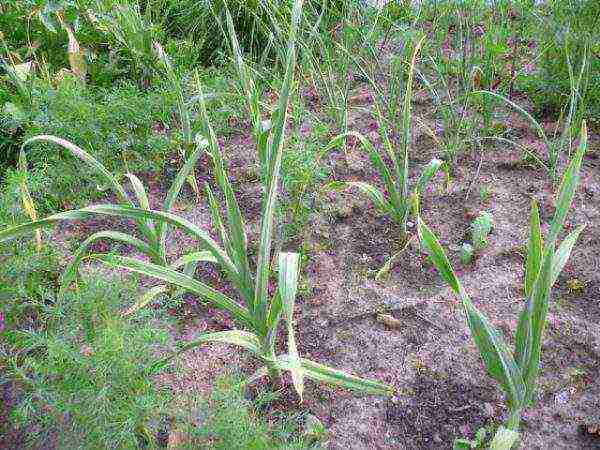
Description of the onion and garlic hybrid
Now let's move on to the description. The rocamboll garlic belongs to the lily family, and is a large large perennial herb. In Russia, it has been known about it since the 19th century, but it was most widespread in Europe and Asian countries, where this vegetable is grown on an industrial scale.
The greenery of the plant looks like a fleshy trunk, from which dense leaves, up to 6 centimeters wide, extend. They are painted in a rich light green color and are covered with a silvery coating. Depending on the growing conditions, the height of the leaves can reach 80-120 centimeters.
In the middle of summer, the rockumbol produces a peduncle on which small, purple, bell-shaped flowers are formed. They gather in spherical inflorescences. It is worth noting that these flowers do not form fruit, therefore they are essentially useless and it is recommended that they be removed immediately with the arrow.
The underground part of the plant is a giant bulb, consisting of 4-6 cloves, covered with dense and fibrous scales. On average, such a bulb reaches 6 centimeters in diameter and a weight equal to 100 grams, but with proper care and the introduction of the necessary nutrients, these indicators can be increased to 10 centimeters and 300 grams.
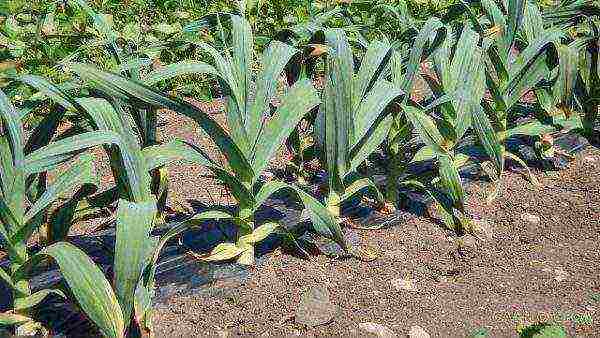
In the first year after planting the cloves, one should not wait for a full-fledged harvest, usually one-toothed teeth are formed first. When they are subsequently planted, a garlic head is formed in the ground, under the bottom of which children grow. Their number can vary from 4 to 20 pieces.
The taste of such a giant garlic vaguely resembles an onion, it is less spicy, but at the same time rich. The pulp is juicy, does not exude a strong odor.
Landing time of the wild giant of Rockumball
The timing for the exact planting of onion garlic can be determined based on the selected variety:
- spring rockambol planted in early spring, immediately after the soil warms up to 4-6 degrees, usually such indicators occur in early to mid-April;
- winter varieties planted in open ground before winter, 3-4 weeks before frost.Depending on the climatic conditions of the region, this time can come from the end of September to the middle of October;
- it's worth noting that rockumbol has universal varietieswhich can be planted both in early spring and late autumn.
Teeth or children are used as planting material, which are formed under the bottom of the head. You can also deepen the one-toothed teeth into the ground, which will appear after the first season of growing rockambol.
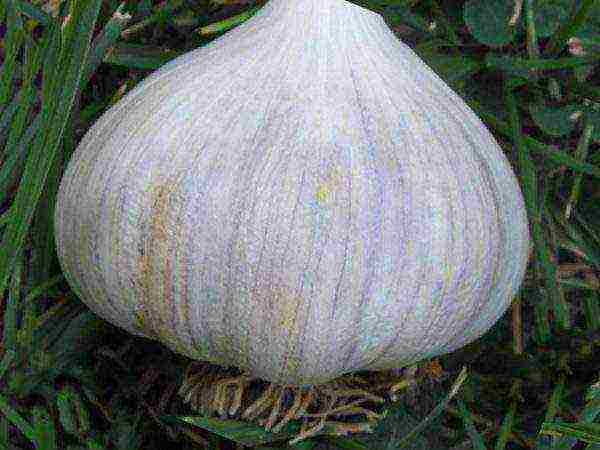
Before planting, the material must be prepared. To begin with, it is sorted by type and size, so that the plantings are more uniform, diseased and damaged teeth are removed at the same time. Then the planting material is carefully cleaned of the upper scales and soaked in a weak solution of potassium permanganate a day before planting.
Planting a useful plant
Before planting rockambol in open ground, the soil must be prepared; for this, the dense soil is loosened to a depth of 25-30 centimeters, while light soils will be loosened to a depth of 10-15 centimeters. At the same time, the soil should be cleared of weeds, stones and other debris.
For such a crop, soils with an acidity in the range of 6.5-7.5 Ph are best suited. In the event that the indicators do not correspond to the soil, you can make it less acidic using dolomite flour or ash. To increase the fertility of the soil, 30 kilograms of humus or rotted manure are introduced for each square meter.
During planting, the planting material is placed on the furrows, which are placed at a distance of 30 centimeters from each other. The distance between individual plants will be 12-15 centimeters. The denticles are buried strictly vertically to a depth of 10 centimeters. The soil must be moist when planting.
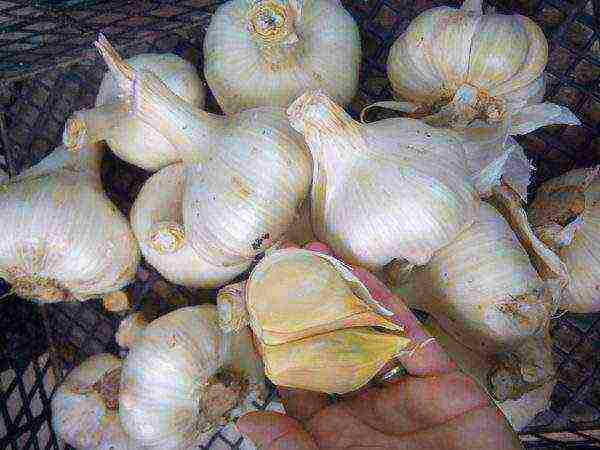
In autumn, immediately after planting, the soil must be mulched. This is necessary so that the garlic does not freeze during the winter frosts. Mulch is laid out in a 5-centimeter layer; straw, sawdust, peat, etc. can be used as material.
Care rules for growing a large variety
Rocambol has long been adapted to growing in the harsh Russian climate, therefore, in order to obtain a rich harvest, it will be enough for a gardener to carry out all agrotechnical work on the construction of a crop in time.
Garlic onions need regular watering, during the period of active plant growth, this procedure is repeated 1 time in 3-4 days, using up to 12 liters of water per square meter of planting. After the head is formed, the rockambol is watered as the soil dries up.
Like many other plants, rockumbol needs timely feeding. Usually, this procedure is carried out 3 times per season:
- before the sprouts appear, nitrogen fertilizers must be applied, these include urea, ammonium nitrate, etc.;
- during the active growth of garlic, 1 square meter of plantings is watered with 3 liters of a solution prepared from 200 grams of bird droppings, 20 grams of urea and 10 liters of water;
- during the formation of the heads, phosphorus-potassium fertilizers are applied.
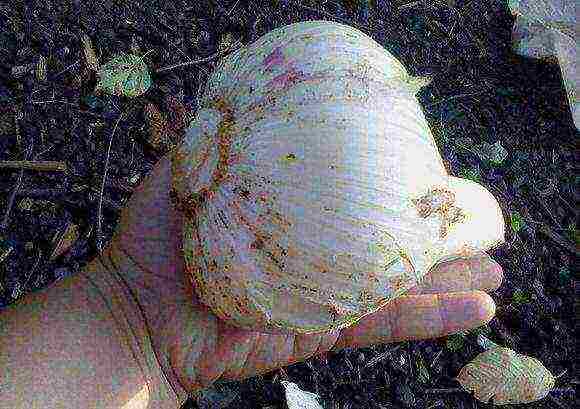
When growing rockumbol, do not forget about mulch, with which you can restrain the growth of weeds and maintain the necessary soil moisture for a longer time.
Collecting and storing a giant harvest
The collection of garlic onions is carried out after the lower leaves of the plant turn yellow. The fruits are carefully dug up and cleaned from the ground, after which preparation for storage begins:
- Within 30 days, the garlic is dried outdoors under a canopy or in a well-ventilated area. The resulting heads are afraid of open sunlight, they can wrinkle from it and lose their unusual taste;
- After the heads are dry, it is necessary to trim the foliage, leaving only a small tail;
- Until spring, the fruits are stored in a dry room with a temperature of no higher than 9 degrees.
Rocambol is an unusual garden crop, a mixture of both onions and garlic. The resulting fruits have a pleasant taste. It is quite simple to grow such a plant, it is not demanding on the climate and other weather conditions.
